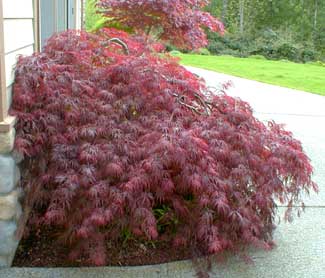
'Crimson Queen'
Weeping Red Laceleaf;
or, Cutleaf or Threadleaf
Japanese Maple
"The autumn air sweeps faint & chill
Across the maple-crested hill."
-Margaret Junkin Preston
(1820-1897)
(1820-1897)
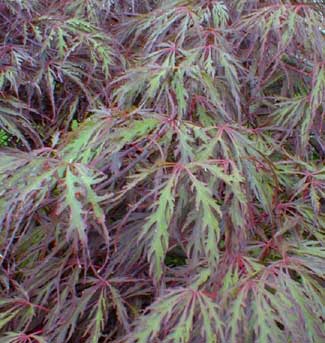 Beginning in the mid-1960s, Acer palmatum variant dissectum forma atropurpureum 'Crimson Queen' was by many regarded the best dissectum or laceleaf Japanese maple -- until 'Red Dragon' began to displace it to large extent in public sentiment, because 'Red Dragon' remains redder through summer.
Beginning in the mid-1960s, Acer palmatum variant dissectum forma atropurpureum 'Crimson Queen' was by many regarded the best dissectum or laceleaf Japanese maple -- until 'Red Dragon' began to displace it to large extent in public sentiment, because 'Red Dragon' remains redder through summer.While 'Red Dragon' is also a semi-dwarf weeper, 'Crimson Queen' is a heavily cascading weeper that forms a more nearly perfect dome, & if grown near a ledge are large raised bed can even droop downward lower than its root-crown.
The second-to-last photo on this page shows a very short six-to-eight foot wide 'Crimson Queen' growing around the corner from me in a neighbor's yard; it's a virtual groundcover that has cascaded down a step & begun to creep out onto a concrete patio.
The very last photo is of another specimen in my immediate neighborhood, about eight feet wide & five high from the crown, but seemingly taller because the weeping limbs reach way down a stone wall.
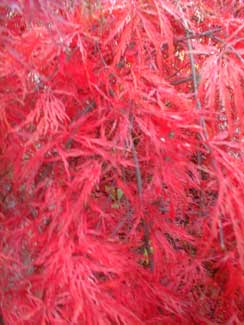 Without a ledge to extend itself downward, it will need almost annual pruning to shorten limbs that will otherwise press into the ground.
Without a ledge to extend itself downward, it will need almost annual pruning to shorten limbs that will otherwise press into the ground.A young specimen can be staked for more upward growth, as otherwise it strongly desires to turn itself downward. It is also sometimes grown with a multi-stem form as a giant shrub.
At an estate where I've done landscaping, & took the first three photos, two specimens are of classic low-graft single-trunked dome-shaped weepers. One of them, as you can see in the first photo, was planted much too near the house, by the property's previous owner.
Undoubtedly when first planted it was just the right size for the six-foot-wide semi-circlular hole in the patio concrete, someone obviously not realizing how vigorous they can be in growth, not in height but in width. There are weeping cultivars that would have remained small enough for the space without so much attention to its training, but it's too late to select properly now.
Efforts have been made to prune it to its alloted space. It now needs annual or twice-annual pruning to keep it from spreading over the entire patio.
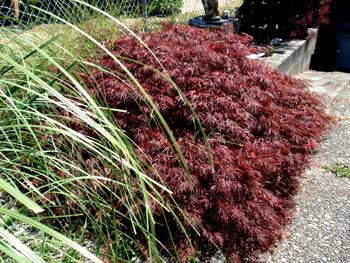 Its widening growth-rate is actually annoying due to this location, with always the risk of an inelegant cut when such persistent pruning is required. The day could well come that it'll need to be sacrificed. So good thing it wasn't one of the rarer cultivars.
Its widening growth-rate is actually annoying due to this location, with always the risk of an inelegant cut when such persistent pruning is required. The day could well come that it'll need to be sacrificed. So good thing it wasn't one of the rarer cultivars.A gardener unfamiliar with the actual mature size of 'Crimson Queen' is easily fooled by the designation "dwarf," then surprised that that by no means indicates permanent tininess.
A typical 'Crimson Queen' is generally encountered in the four to six foot range of height, & ten feet wide. It requires artful, restrained pruning & training to certainly grow no larger.
The lacy, finely cut foliage emerges purple-red in April, soon aging to burgundy. The first photo above shows it in April. If protected in dappled sunlight or bright shade it might hold the burgundy color throughout of summer, then turn bright crimson for autumn, as shown in the third photo from November.
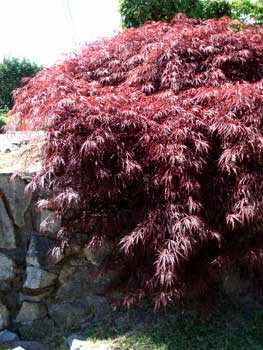 In a more exposed area, it will turn green by high summer, with burgundy remaining only at the leaf edges, as shown in the second photo, from August.
In a more exposed area, it will turn green by high summer, with burgundy remaining only at the leaf edges, as shown in the second photo, from August.If 'Crimson Queen' is situated in too much sun it will have a tendency to leaf-scorch at high summer, spoiling the perfection of its color.
One of the goals of breeding purple maples is to get strains that will remain purple throughout summer, but there is nothing wrong with the two-tone summer leaves.
The manner by which 'Crimson Queen' marks the seasons -- purple for spring, bicolor for summer, bright red for autumn, then revealing its limb structure for winter -- makes it an all-season delight.
Spring's bright red flowers occur about the same time the leaves are beginning. They are much too small to have a showy effect & are instantly lost in the bursting foliage, but are exciting to observe in close. They develop with extreme rapidity into small samaras or winged seeds, which take until autumn to ripen.
Propagation, however, is rarely from the samaras, but is almost exclusively from grafted cuttings. It can be grown from seed, but variation is so broad that the resulting tree could not be considered 'Crimson Queen.'